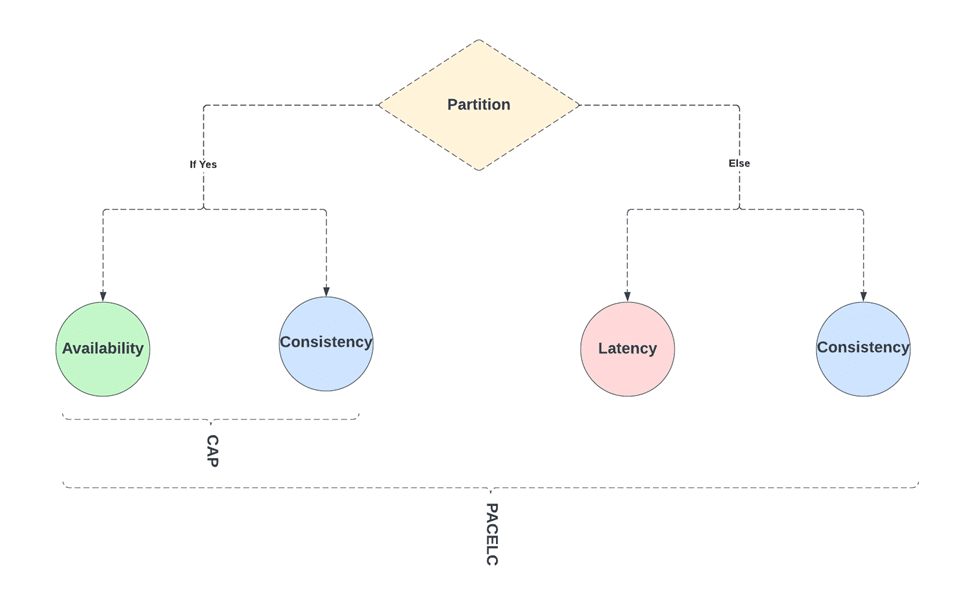Beyond CAP Theorem
In this tutorial, we are going to discuss about Beyond CAP Theorem. While the CAP theorem has been fundamental to distributed systems design, it is essential to recognize that it represents a simplified view of the trade-offs in distributed systems. In recent years, researchers and practitioners have started exploring more nuanced ways of understanding and addressing the challenges in distributed systems.
Beyond CAP theorem, several other principles, concepts, and considerations are relevant to the design and implementation of distributed systems. Let’s explore the beyond CAP theorem. Here are a few:
Extended CAP (ECAP) Model
The Extended CAP model expands the original CAP theorem by considering latency as a fourth dimension. The ECAP model posits that it is impossible to optimize for all four properties—consistency, availability, partition tolerance, and latency—simultaneously. In this model, system designers must choose which three properties to prioritize, based on the requirements and constraints of their specific application.
PACELC Theorem
The PACELC theorem is another extension of the CAP theorem that takes latency and consistency trade-offs into account. PACELC stands for “Partition (P), Availability (A), Consistency (C), Else (E), Latency (L), Consistency (C).” This theorem states that in case of a network partition, a system must choose between availability and consistency (similar to CAP), but when the system is operating normally (no partitions), it must choose between latency and consistency. This highlights the fact that trade-offs exist even in the absence of network partitions.

CRDTs and Hybrid Systems
Convergent Replicated Data Types (CRDTs) are data structures designed to allow multiple replicas to be updated independently and converge to a consistent state without requiring coordination. CRDTs can help system designers achieve both strong eventual consistency and high availability. By combining CRDTs with other techniques, it is possible to build hybrid systems that provide tunable consistency guarantees, enabling applications to make trade-offs based on their specific requirements.
Application-specific trade-offs
The CAP theorem and its extensions provide valuable insights into the fundamental trade-offs in distributed systems design. However, it is crucial to remember that real-world systems often involve more complex and application-specific trade-offs. As a system designer, it is important to understand the unique requirements and constraints of your application and make informed decisions about the trade-offs that best meet those needs.
BASE (Basically Available, Soft state, Eventually consistent)
BASE is an alternative set of principles for distributed systems design that contrasts with the ACID (Atomicity, Consistency, Isolation, Durability) properties of traditional databases. BASE emphasizes availability and partition tolerance over strong consistency, advocating for systems that are “basically available” and eventually consistent, with soft state that may change over time.
ACID Properties
While the CAP theorem focuses on distributed systems, the ACID properties are fundamental to traditional database systems. ACID stands for Atomicity, Consistency, Isolation, and Durability, which are key properties that ensure data integrity and reliability in transactional databases.
Eventual Consistency
Eventual consistency is a consistency model where updates to a distributed system eventually propagate to all replicas and converge to a consistent state. Unlike strong consistency models, eventual consistency does not guarantee that all replicas have the same data at all times but ensures that they will eventually reach a consistent state.
Consensus Algorithms
Consensus algorithms such as Paxos and Raft are fundamental building blocks for achieving consistency and fault tolerance in distributed systems. These algorithms enable a set of nodes to agree on a single value even in the presence of failures or network partitions.
Quorum Systems
Quorum systems are used in distributed databases to determine how many replicas must agree on an update before it is considered successful. Quorum-based replication schemes provide a balance between consistency, availability, and fault tolerance by allowing systems to tolerate a certain number of failures while ensuring data consistency.
Distributed Transactions
Distributed transactions allow multiple operations across different nodes in a distributed system to be treated as a single transaction, ensuring atomicity and consistency across the entire system. Implementing distributed transactions in a scalable and fault-tolerant manner is a complex challenge in distributed systems design.
Sharding and Partitioning
Sharding and partitioning involve dividing data into smaller subsets and distributing them across multiple nodes in a distributed system. This approach improves scalability and performance by distributing the workload, but it also introduces challenges related to data distribution, consistency, and query routing.
Replication Strategies
Replication strategies involve maintaining multiple copies of data across different nodes in a distributed system to improve fault tolerance, availability, and performance. Different replication models, such as master-slave replication, multi-master replication, and eventual consistency, offer different trade-offs in terms of consistency, availability, and scalability.
These concepts complement the CAP theorem and provide additional insights and considerations for designing and building distributed systems that meet the requirements of modern applications.
While the CAP theorem has been foundational to understanding the trade-offs in distributed systems, it is essential to explore and consider more nuanced models and techniques to design systems that effectively address the challenges and requirements of modern applications.
That’s all about the Beyond CAP Theorem. If you have any queries or feedback, please write us email at contact@waytoeasylearn.com. Enjoy learning, Enjoy system design..!!